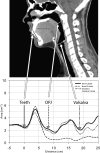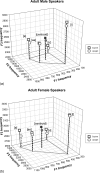Effect of body position on vocal tract acoustics: Acoustic pharyngometry and vowel formants
- PMID: 26328699
- PMCID: PMC4545056
- DOI: 10.1121/1.4926563
Effect of body position on vocal tract acoustics: Acoustic pharyngometry and vowel formants
Abstract
The anatomic basis and articulatory features of speech production are often studied with imaging studies that are typically acquired in the supine body position. It is important to determine if changes in body orientation to the gravitational field alter vocal tract dimensions and speech acoustics. The purpose of this study was to assess the effect of body position (upright versus supine) on (1) oral and pharyngeal measurements derived from acoustic pharyngometry and (2) acoustic measurements of fundamental frequency (F0) and the first four formant frequencies (F1-F4) for the quadrilateral point vowels. Data were obtained for 27 male and female participants, aged 17 to 35 yrs. Acoustic pharyngometry showed a statistically significant effect of body position on volumetric measurements, with smaller values in the supine than upright position, but no changes in length measurements. Acoustic analyses of vowels showed significantly larger values in the supine than upright position for the variables of F0, F3, and the Euclidean distance from the centroid to each corner vowel in the F1-F2-F3 space. Changes in body position affected measurements of vocal tract volume but not length. Body position also affected the aforementioned acoustic variables, but the main vowel formants were preserved.
Figures





Similar articles
-
Source and Filter Acoustic Measures of Young, Middle-Aged and Elderly Adults for Application in Vowel Synthesis.J Voice. 2024 Mar;38(2):253-263. doi: 10.1016/j.jvoice.2021.08.025. Epub 2021 Oct 28. J Voice. 2024. PMID: 34756498
-
Vowel acoustic space development in children: a synthesis of acoustic and anatomic data.J Speech Lang Hear Res. 2007 Dec;50(6):1510-45. doi: 10.1044/1092-4388(2007/104). J Speech Lang Hear Res. 2007. PMID: 18055771 Free PMC article.
-
A model of acoustic interspeaker variability based on the concept of formant-cavity affiliation.J Acoust Soc Am. 2004 Jan;115(1):337-51. doi: 10.1121/1.1631946. J Acoust Soc Am. 2004. PMID: 14759026
-
A systematic review and Bayesian meta-analysis of the acoustic features of infant-directed speech.Nat Hum Behav. 2023 Jan;7(1):114-133. doi: 10.1038/s41562-022-01452-1. Epub 2022 Oct 3. Nat Hum Behav. 2023. PMID: 36192492
-
Research in methodologies for modelling the oral cavity.Biomed Phys Eng Express. 2024 Mar 18;10(3). doi: 10.1088/2057-1976/ad28cc. Biomed Phys Eng Express. 2024. PMID: 38350128 Review.
Cited by
-
The Reliability of Oral and Pharyngeal Dimensions Captured with Acoustic Pharyngometry.Dysphagia. 2016 Aug;31(4):555-9. doi: 10.1007/s00455-016-9713-y. Epub 2016 Jun 4. Dysphagia. 2016. PMID: 27262868 Free PMC article.
-
The Swallowing Profile of Healthy Aging Adults: Comparing Noninvasive Swallow Tests to Videofluoroscopic Measures of Safety and Efficiency.J Speech Lang Hear Res. 2018 Jul 13;61(7):1603-1612. doi: 10.1044/2018_JSLHR-S-17-0471. J Speech Lang Hear Res. 2018. PMID: 29893767 Free PMC article.
-
Tongue Postures and Tongue Centers: A Study of Acoustic-Articulatory Correspondences Across Different Head Angles.Front Psychol. 2022 Jan 17;12:768754. doi: 10.3389/fpsyg.2021.768754. eCollection 2021. Front Psychol. 2022. PMID: 35111103 Free PMC article.
-
Static measurements of vowel formant frequencies and bandwidths: A review.J Commun Disord. 2018 Jul-Aug;74:74-97. doi: 10.1016/j.jcomdis.2018.05.004. Epub 2018 Jun 1. J Commun Disord. 2018. PMID: 29891085 Free PMC article. Review.
-
An age-dependent vocal tract model for males and females based on anatomic measurements.J Acoust Soc Am. 2018 May;143(5):3079. doi: 10.1121/1.5038264. J Acoust Soc Am. 2018. PMID: 29857736 Free PMC article.
References
-
- Brown, I. B. , McClean, P. A. , Boucher, R. , Zamel, N. , and Hoffstein, V. (1987). “ Changes in pharyngeal cross-sectional area with posture and application of continuous positive airway pressure in patients with obstructive sleep apnea,” Am. Rev. Respir. Dis. 136, 628–632.10.1164/ajrccm/136.3.628 - DOI - PubMed
Publication types
MeSH terms
Grants and funding
LinkOut - more resources
Full Text Sources
Other Literature Sources
Medical
Miscellaneous

